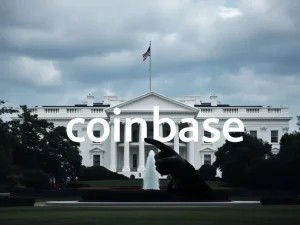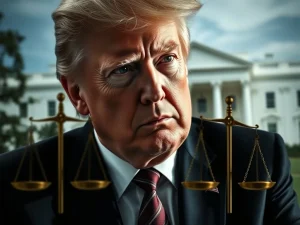US Senate Advances Crucial ‘Crypto-Friendly’ Fed Pick Stephen Miran

A pivotal moment for the cryptocurrency landscape unfolded as the US Senate Banking Committee recently advanced the nomination of Stephen Miran. This move signals a potentially significant shift in the Federal Reserve’s approach to digital assets, attracting considerable attention from the crypto community and policymakers alike. Miran, often characterized as a ‘crypto-friendly‘ figure, now awaits a full Senate vote for a temporary position on the Federal Reserve Board of Governors.
Stephen Miran’s Path to the Federal Reserve
The journey for Stephen Miran to a potential seat on the Federal Reserve Board of Governors has been closely watched. President Donald Trump initially selected Miran to chair the Council of Economic Advisors in December. His nomination to the Fed Board follows the resignation of another member in August, creating a vacancy. During a recent hearing, Miran clarified that he would not resign from his advisory role with the White House if his tenure as a Fed governor were extended beyond January. This commitment highlights his dedication to policy influence.
The Senate Banking Committee’s vote, conducted along party lines, saw a 13-to-11 approval, with all Democrats opposing and Republicans supporting the nomination. This partisan split underscores the political intricacies surrounding high-profile appointments, especially those with implications for emerging financial technologies like cryptocurrencies. If confirmed, Miran would fill a term that concludes on January 31, providing a temporary but potentially influential voice within the central bank.
Miran’s Stance on Digital Assets and Innovation
While Stephen Miran has maintained a relatively low public profile regarding blockchain and digital assets since joining the Trump administration, his past remarks offer insight into his perspective. In a December interview, he notably stated that “crypto has a big role potentially to play in innovation.” This comment, though brief, resonated with advocates of digital currencies, suggesting an open-minded approach to the evolving financial technology sector. Such a stance is particularly relevant given the Federal Reserve‘s increasing engagement with topics like stablecoins and tokenization.
His ‘crypto-friendly‘ label stems primarily from these earlier signals. Industry observers are eager to see if his potential role at the Fed would translate into tangible policy support or a more nuanced regulatory framework for the burgeoning digital economy. The Fed’s influence on monetary policy, banking supervision, and payment systems makes any new governor’s views on crypto highly significant for market participants.
The Broader Political Context and Challenges
Miran’s nomination comes amidst a period of heightened political tension and legal battles involving presidential appointments. A notable parallel is the ongoing dispute surrounding Fed governor Lisa Cook. President Trump had demanded Cook’s “immediate removal from office” in an August 25 letter, citing mortgage fraud claims. However, Cook challenged this dismissal in court, asserting the independence of government agencies.
On Tuesday, a District of Columbia federal judge blocked Trump’s order, ruling that the president had not provided sufficient cause for dismissal. The administration promptly filed a notice of appeal on Wednesday, indicating a continued legal struggle. This backdrop of executive challenges and judicial interventions highlights the complexities of presidential power and the checks and balances inherent in the US political system. These events could shape how future appointments, including Miran’s, are perceived and processed by the US Senate.
The Federal Reserve’s Evolving View on Crypto
The Federal Reserve has shown a growing interest in digital assets and the broader implications of blockchain technology for the financial system. In October, the central bank is scheduled to host a significant conference. This event will focus on issues related to payments, including the rapidly expanding stablecoin market and the potential of tokenization. Such discussions indicate the Fed’s proactive approach to understanding and potentially regulating these innovative financial instruments.
A governor like Stephen Miran, with a publicly expressed interest in crypto’s innovative potential, could significantly influence these ongoing dialogues. His presence might help bridge the gap between traditional financial regulation and the unique characteristics of digital currencies. The outcomes of these discussions and the direction of future Fed policy will undoubtedly have profound effects on the development and adoption of cryptocurrencies within the United States.
What Miran’s Confirmation Could Mean for Digital Assets
The potential confirmation of Stephen Miran could usher in a period of increased clarity and, perhaps, more favorable regulatory conditions for digital assets. A ‘crypto-friendly‘ voice within the Federal Reserve might advocate for policies that foster innovation while addressing legitimate concerns about financial stability and consumer protection. This could include developing clear guidelines for stablecoins, exploring central bank digital currencies (CBDCs), or even influencing the broader regulatory stance of other agencies like the SEC.
Conversely, even a temporary appointment could set precedents. Miran’s actions and statements during his term, however brief, could shape future discourse and policy directions. The crypto community will be watching closely for any signals regarding the Fed’s willingness to embrace or restrict digital innovation. His role, if confirmed, would represent a direct link between the White House’s economic advisory team and the nation’s central bank, potentially streamlining policy coordination on emerging financial technologies.
The Road Ahead for Crypto Regulation
The advancement of Stephen Miran’s nomination by the US Senate Banking Committee is a critical development in the ongoing narrative of crypto regulation. It highlights the increasing integration of digital assets into mainstream political and economic discussions. As the Senate prepares for a full vote, the implications for the future of cryptocurrency in the United States remain a central topic of debate.
The broader regulatory environment continues to evolve, with various government bodies grappling with how best to oversee this dynamic sector. The Federal Reserve’s role is particularly crucial, given its mandate over monetary policy and financial stability. Miran’s potential influence could contribute to a more coherent and forward-thinking regulatory framework, or at least spark more vigorous debate within the Fed. Ultimately, the confirmation process and Miran’s subsequent actions will offer valuable insights into the future direction of crypto policy at the highest levels of government.







